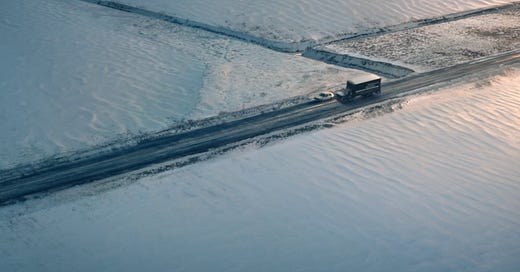Wordless Cold Opens: SEVERANCE
This wordless cold [below zero!] opening of Severance 2.03 "Who Is Alive?" starts with a wonderful cut-on-action from ultra-wide to closeup, uses (and never re-uses) eight different angles, and makes great use of one huge key light source (the sun and the 'sun').
We’ll step through how the shots work together while looking at some practical requirements of shooting a scene like this: how to ensure you can cut on action, planning for exterior versus interior shots, and what to consider if you don’t plan on repeating angles.
Cut On Action
The establishing wide shows a truck enter frame, then just as it passes the car the scene cuts to a closeup within the car, which is a slightly startling cut, which gives us a similar feel to Harmony Cobel being startled awake.
If you’re scraping together your own change to make an indie film, or possibly even if you’re a network TV show on a tight budget and tighter schedule, you could have a camera in the car filming simultaneously with the wide shot.
Using two cameras won’t determine whether the cut will match — the difference in angle is too massive, we can’t see anyone in the car, let alone that is’s Harmony or what position she’s in or when she moves. But two cameras can save time with simultaneous setups; you lessen your risk of ‘losing the light; and you save time and money because the truck won’t have to reset as many times. On a small enough shoestring you might use a pocket camera or fancy cell phone for the interior car shot.
But on a ‘prestige’ TV show with a ~$200 million dollar budget, every single one of these shots is its own setup. You don’t need to worry about losing the light, you have enough lights and crew to emulate the sun . . . though you still prioritise getting certain shots first.
Unique Angles and Shot Order
The shots (pictured below in order L-R top-to-bottom) run:
1. ultrawide EXT
2. MCU INT
3. Medium EXT
4. CU EXT/INT (the camera is EXT but so close to the windshield all we see is INT
5. CU INT low angle
6. CU INT Over-the-Shoulder
7. ECU INT
8. Medium Ext
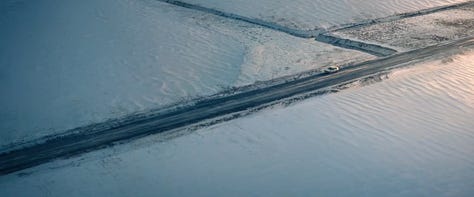

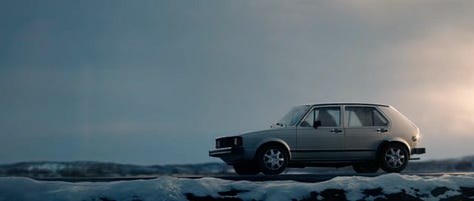
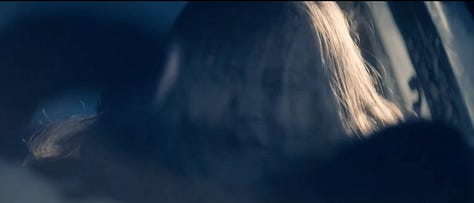

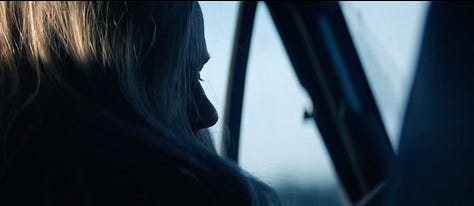
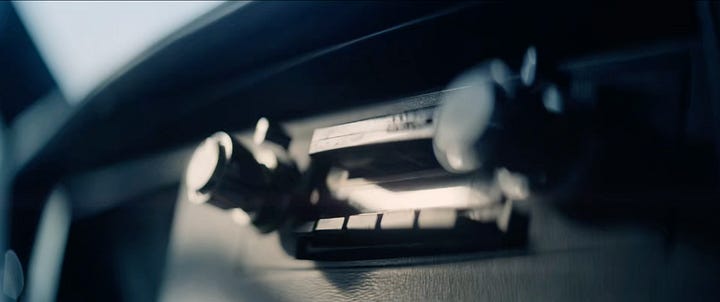

It does seem likely the plan was not to repeat or re-use any shot here, because for a wordless cold open the changing angles keep us both wondering ‘what the . . .’ and trying to process new visual information.
But on a practical note, Having wider exteriors means there’s always a ‘safety’ to cut to if the interior-to-interior cut doesn’t work, and a closeup of an object such as a tape deck, speedometer, etc can also break shots up.
It’s also possible-to-likely they shot one or two additional exteriors, if not also ECUs of other items in the car or other angles for Harmony (for example, her POV looking at gloved hands wiping the windshield), and then worked with the editors to find the right rhythm and timing because for a scene like this those are crucial, and can be the most difficult to judge no matter how thorough your storyboards are.
Speaking of rhythm and timing . . .
Exterior / Interior
Moving between exterior and interior is a key part of the feel of the scene, but you’re rarely going to shoot anything that way; you often light and set up for your widest exterior first, then move closer, then your widest interior and move to your closest shot. Obviously the pragmatics of locations and weather and gear and crew will change that, but it’s a good starting rule of thumb.
If money is your biggest consideration, you might shoot everything with the truck first, then go widest shot to closest.
But if money is no object, you shoot for what’s going to look the prettiest. Thus, exterior shots where you see the sky around the car are most important (#1, #3, #8).
After that, you can light everything with powered lights, or even back in the studio for shots like the windshield scrape and radio (#4 and #7).
Finally, if you really need to — say a storm rolls in, or scheduling reasons mean you can only get half the shots you want out on the abandoned road location — you could also shoot on a soundstage (#5 and #6).
For example, all you need for a shot #5 (below) is a swatch of blue behind the car window, lighting to properly replicate how the sun looked, and additional lighting and camera work to match the colour temperature to the shots captured on location (obviously a colourist has work to do on every shot, no matter what, but what’s captured determines how close they can get the shots).
Takeaways
When you’re creating a scene which won’t repeat shots — especially when you’re shooting on location and moving from an extreme wide shot to an extreme closeup — everything from planned edit order to contingencies for weather to shot setup order are important to the final product.
The Severance crew’s attention to detail allows it to look so. damn. excellent.

